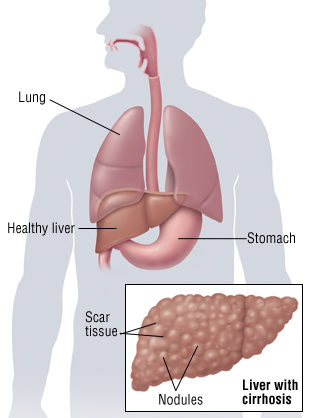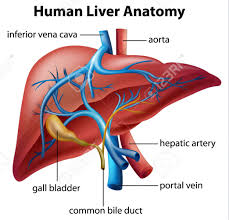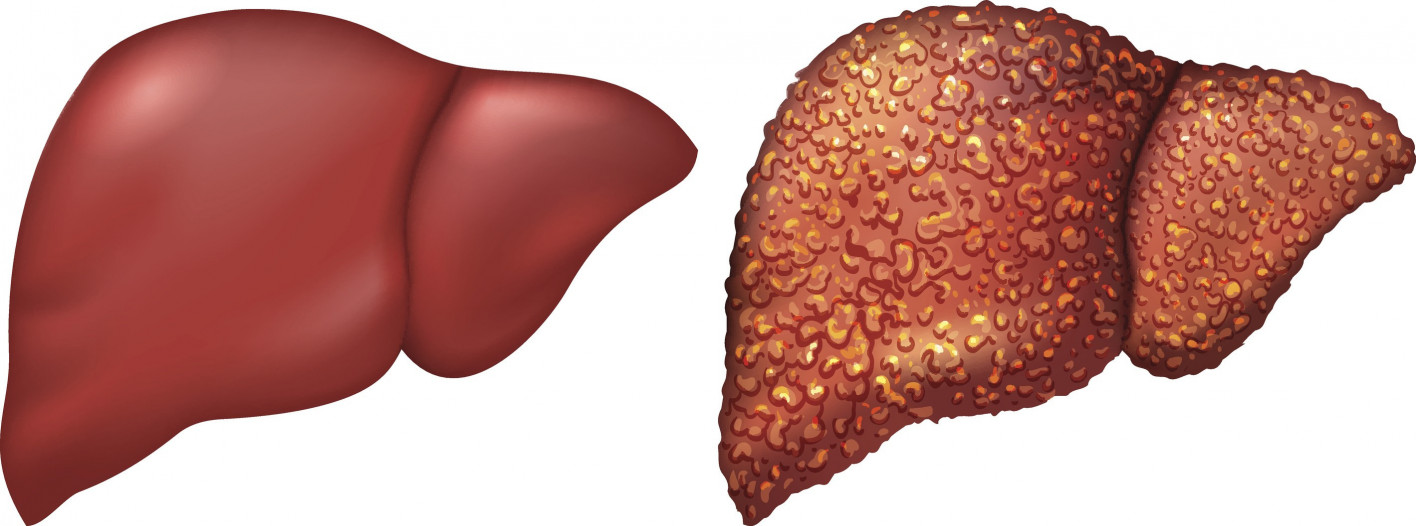Cirrhosis is a disease characterized by a gradual replacement of healthy tissue of the liver nodules and fibrous tissue (fibrosis) that alter gradually liver function. This is a serious and progressive disease. Cirrhosis is often the result of chronic liver disease, for example, due to excessive use of alcohol or virus infection (hepatitis B or C). This inflammation or persistent causes this damage, which results in few or no symptoms for a long time, eventually leads to irreversible cirrhosis, which destroys the liver cells. Cirrhosis is the advanced stage of chronic diseases of the liver.
Cirrhosis: Who is affected?
In France, the prevalence of cirrhosis is estimated at 2 000 to 3 300 cases per million population (0.2 to 0.3%) and estimated that there are 150 to 200 new cases per million people each year. In total, about 700 000 people with cirrhosis in France, and we deplore 10,000 to 15,000 deaths per year related to this affection. The global prevalence of the disease is unknown, but it oscillates around the same numbers in North America and Western countries than in France. There is no accurate epidemiological data for Canada, but it is known as cirrhosis kills about 2,600 Canadians each year. This condition is more common in Africa and Asia, and hepatitis B and C have spread diseases and often poorly supported.
Cirrhosis Symptoms
When cirrhosis has progressed sufficiently to cause symptoms, they include generally:
- Fatigue, loss of appetite, and weight loss are often the first signs
- Nausea and diarrhea
- An increase in the volume of the abdomen due to the accumulation of fluid.
- Fluid accumulation in the legs causing swelling
- Gastrointestinal bleeding is caused by portal hypertension (this is an emergency that requires immediate hospitalization). It results in vomiting blood or black stools (with blood).
- Ecchymosis (blue =) or easy bleeding
- Itching (pruritus)
- Jaundice (jaundice) that’s associated with previous symptoms.
To confirm the diagnosis of cirrhosis, a liver biopsy was performed to visualize the fibrotic lesion’s characteristics.


Cirrhosis: People at risk
The causes of cirrhosis are diverse; so, the at-risk groups belong to different categories:
- Men over 50 are generally more affected by chronic hepatitis C and alcoholic cirrhosis
- People with metabolic syndrome, with overweight or obesity, insulin resistance, or type 2 diabetes, hypertension, and hyperlipidemia, are at risk of developing “nonalcoholic fatty liver disease.
Cirrhosis: Risk factors
Many preventable risk factors are associated with cirrhosis, in particular:
- Consumption of excessive alcohol. This is the main avoidable risk factor for cirrhosis. However, other factors come into play in the development of the disease: only 10 to 15% of alcoholics have a hepatic disease.
- Being infected with a hepatitis virus (B or C) is also a major liver cirrhosis risk factor.

Medical treatment
Cirrhosis is an irreversible disease, against which there is no truly effective treatment (except liver transplantation).
We must first deal with the cause of cirrhosis and reduce aggravating factors:
- In the case of alcoholic cirrhosis, weaning is essential.
- In a case of cirrhosis associated with metabolic syndrome, it is necessary to lose weight, control diabetes with treatment followed, and lower the levels of lipids in the blood.
- In the case of viral hepatitis, antiviral treatment, administered.
More generally, the High Authority of Health emphasizes the importance of:
- Preventing and treating complications of cirrhosis (gastrointestinal bleeding, bacterial infections, hepatocellular carcinoma, etc.)
- Update your vaccinations (hepatitis A, hepatitis B, flu, pneumococcus)
- Adopt lifestyle changes (in particular oral care)
- Benefit from comprehensive support

Cirrhosis: Changes in lifestyle
In the case of cirrhosis, it is urgent to stop addictive behavior involved or associated with illness. It is particularly important to:
- Stop alcohol consumption, whatever the cause of cirrhosis. In people suffering from alcohol dependence several accompanying measures exist and implemented (support groups, drug treatments, etc.)
- Stop smoking because it aggravates the disease. Nicotine replacement therapy was used, and a drug weaning aid.
- Stop the consumption of medicines and drugs that can have a toxic effect on the liver. We must especially avoid taking drugs that are metabolized by the liver (the doctor or pharmacist will inform you).
- If ascites (fluid in the abdomen), your doctor may advise taking diuretics to remove water and a low-salt diet. Punctures are sometimes necessary to discharge the liquid.

Management of hepatitis involved
If cirrhosis associated with chronic hepatitis, it is necessary to treat hepatitis:
- By antiviral treatment with interferon α and/or lamivudine in cases of post hepatitis B cirrhosis
- By α interferon when post-hepatitis C cirrhosis (optionally in combination with ribavirin). New and more effective treatments for hepatitis C (current drugs do not cure 50% of people) are development.
- In the case of active autoimmune disease underlying treatments with corticosteroids or immunosuppressive drugs (azathioprine) were implemented quickly.

Liver transplantation
If cirrhosis advanced and threatens the life of the person, the only possible treatment is liver transplantation (or liver transplant). This is risky, however, and organ waiting times are long, at least 1 to 2 years in France and North America.
Psychological care
Cirrhosis is a serious and progressive disease, and diagnosis inevitably has psychological repercussions. If it deems necessary, cirrhosis of person able to receive psychological support.

Liver cancer, the main silent symptoms to never ignore
The new liver cancer factor is NAFLD. The increase in liver cancer associated with obesity and diabetes has become the main factor for years. But the mere fact of being overweight does not necessarily make you a candidate for liver cancer, the doctors noted. “Even if there are many obese people in North America, liver cancer is still relatively rare. Still, the more you risk, the more you should worry and talk to your doctor.
You experience unusual abdominal pain
Most people suffering from liver cancer experience pain in the upper abdomen, the doctor said: “When I look at an asymptomatic patient, the patient said he was hurt when I press on the liver,”. Pain in this region does not necessarily indicate liver cancer – this could also be hepatitis or a problem of the spleen or pancreas.
You lose weight without changing your diet
“A loss of weight or appetite is a common symptom in people who suffer from a lot of different diseases, including some cancers and viruses,”. Sudden weight drop does not necessarily indicate cancer, but still, make sure to ask your doctor if the other symptoms you observed related or not this type of cancer.
You had hepatitis C or B (or have not been vaccinated for hepatitis B)
Other factors can increase the risk of liver cancer, including your health history. Moreover, people who suffered from hepatitis C can develop liver cancer ten years after their diagnosis. And although it has no link with hepatitis C, hepatitis B can also cause this type of cancer. North American children are vaccinated at birth, but people who have not been could contract liver cancer, Every person with hepatitis is monitored by a doctor, he said. He recommended undergoing at least one ultrasound per year to determine if you have cancer or a virus. To test for the presence of alpha-fetoprotein (AFP) in the blood may also help detect this cancer if other tests showed nothing.


